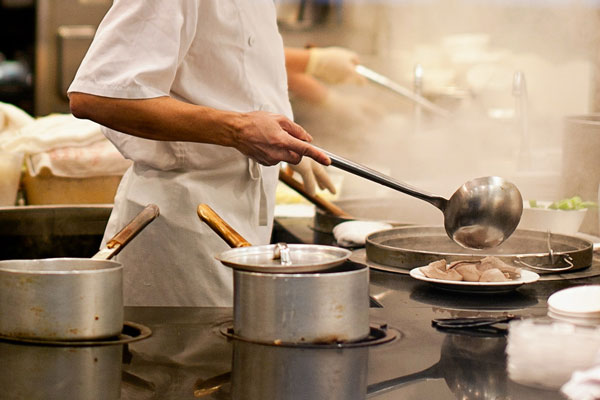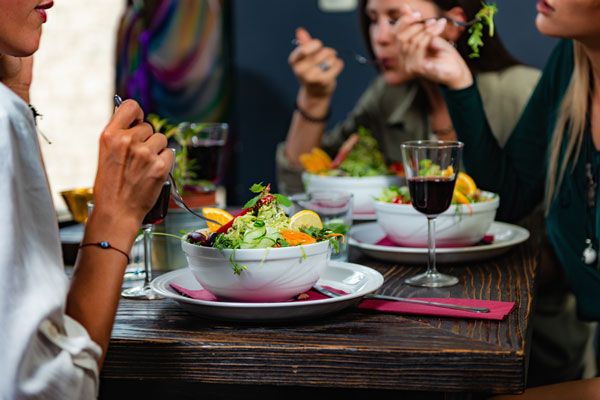SafeFood is Served Here: Check √
A Checklist Approach to Food Safety
In our first blog this month, we discussed risk-based inspections and their importance in any foodservice operation—and we promised to provide you with a risk-based checklist to assist you with daily risk mitigation strategies. Because we appreciate structure and routines (hey, we are RDs or registered dietitians, aka real detailed!) we thought this checklist approach might be useful for managers and their staff in monitoring the safety of food served in their operations.
The key with any checklist is to keep it specific, yet simple. This blog will focus on a checklist for back of the house functions (in September we will provide a sample checklist to address front of house food safety action steps). The checklists cover the food safety fundamentals of employee health and hygiene practices, temperature controls, and cleaning and sanitizing. Think back to the five broad categories of risk discussed in the first August blog and you will find that these fundamentals address those risks. In a nutshell, staff need to remember to restrict times that temperature controlled for safety foods are in the temperature danger zone, follow good hygiene practices as well as work only when healthy, and keep clean surfaces separate from soiled. For each item, we provide a brief description and background, but the checklist you use won’t necessarily need that information.
So, here goes!
Back of House Food Safety Checklist
Employee Health and Hygiene
- Hand wash stations are stocked with needed supplies.
Running, drinkable hot and cold water, soap, and either disposable towels or air dryer
- Hand wash stations are available for use.
Are the hand washing stations accessible so that employees don’t have to complete an obstacle course to use them? Do staff wash hands when and how they should? See signage at FoodHandler!
- No working staff member has been diagnosed with a reportable illnesses.
The Big Six biological contaminants are Shigella spp., Salmonella Thyphi, Nontyphoidal Salmonella, Shiga toxin-producing Escherichia coli, Hepatitis A, and Norovirus.
- No employee on shift has diarrhea, high fever, or other restricted symptoms.
Staff with any of these symptoms should NOT be working with food, and they should NOT be onsite if serving at-risk populations, such as the elderly.
- Gloves in a variety of types and sizes are located close to places used.
Make it easy for staff to select gloves that fit and that are right for the task at hand. See FoodHandler signage to post as a daily reminder.
- Gloves are used as required.
Gloves are one way to avoid bare hand contact with foods. Gloves should be changed at appropriate times – see FoodHandler signage.
- Aprons/Chef Coats are removed when leaving the kitchen.
The apron or chef coats helps with “cooking clean”. If worn to take out garbage or into restroom, there is potential for contamination.
Purchase from Approved Sources
- Food is purchased from suppliers with all required licenses.
Be sure all food items used in the operation can be traced back one step, and that the vendor has controlled for risk. It doesn’t hurt to ask all of your vendors for a letter outlining food safety precautions taken at their link of the food chain – that way you know food is safe when it arrives on your dock.
Food and Temperature Controls
- Food deliveries are checked for quality, correct quantity, and temperature.
Once food is accepted, it belongs to the operation. It is wise to be sure all foods brought into the foodservice have not been temperature abused or been tampered with. Checking that the right amount is delivered helps avoid a crisis mid-production.
- Calibrated thermometers are used to check temperatures of food through the flow of food:
- At Receiving
- In Storage
- During Holding
- At Service
- When Cooling
- When Reheating
Use of a temperature measuring device that is calibrated ensures there is a correct reading. Some thermometers get easily out of whack when bumped or dropped. Set up a schedule to check that measuring tools are accurate. And, use thin-tip thermometers for thin foods.
- Temperature Control for Safety (TCS) Foods are monitored to avoid excessive time in the temperature danger zone.
Remember that bacteria grow very rapidly when in the temperature danger zone (between 41 oF and 135 oF). Keeping hot foods hot and cold foods cold also is a quality indicator. The general rule is to limit time in the TDZ – usually two hours during preparation, and cold food cannot exceed 70 oF. if using Time as a Public Health Control.
- Frozen foods are thawed using appropriate method.
Planning is the best way to avoid temperature abuse while thawing foods. Pulling foods from the freezer with adequate time to thaw under refrigeration is one approach; others include thawing as a part of cooking (which is common with hamburger patties).
- Prepared foods are used within 7 days.
Keeping track of food inventory is critical – both from safety and cost control perspectives! That means that all prepared foods should be labeled with name of food and use-by date or the date placed in storage. Make sure staff follow operational procedures for placement of leftover foods to ensure nothing gets lost in the cooler!
- Hot foods are cooled to below 70 oF within two hours and to below 41 F within an additional four hours.
Remember improper cooling is a leading cause of food borne illness! Cooling foods from above 135 oF to below 70 oF within two hours is critical because that is the “super” temperature danger zone where bacteria grow super quickly, reaching elevated levels which can cause someone to get sick. Use of a blast chiller, chill stick, or portioning the food into smaller units are good strategies to drop temperatures quickly. Avoid placing hot foods directly into the cooler or freezer because this causes strain on the motor, which typically is not large enough to handle regularly. A broken cooler or freezer is not on anyone’s wish list!
- Temperature logs are maintained.
Having temperatures of foods taken as noted above, AND recorded shows proof that there was oversight to avoid temperature abuse. This can demonstrate “reasonable care” by the foodservice in case there is any question that a food borne illness was caused from incomplete cooking or temperature abuse.
Cleaning and Sanitizing
- Food contact surfaces are kept clean.
Clean means free from any visible soil or food. A surface has to be clean before it can be effectively sanitized. Use dedicated containers and designated wiping clothes for cleaning to hold wash and rinse waters
- Food contact surfaces are sanitized.
An approved sanitizing agent or method of sanitizing is used on all surfaces that come in contact with food. These include use of specific chemical agents or high water temperatures. Remember, surfaces need to be clean before they can be sanitized!
- Procedures are in place to avoid cross contamination.
Steps are taken to avoid cross-contamination or re-contamination of clean and sanitized food contact surfaces.
- Employees have designated responsibilities for tasks involving clean OR soiled surfaces, such as assigning two people to dishwashing (one to handle dirty dishes and one to handle clean dishes).
Job duties are structured to keep staff working with clean or only with soiled surfaces to avoid cross-contamination.
- Correct cleaning and sanitizing products and formulations are used.
Cleaning agents and sanitizing chemicals designated for food contact use only are used in the operation. Some custodial products are not intended for food contact surfaces and use could lead to introduction of a chemical hazard.
- Sanitizing methods are tested and documented.
Concentrations when using chemical sanitizing agents or temperatures if heat sanitizing method is used are checked with a test strip and recorded on a log to verify food contact surfaces are sanitized correctly.
Using this checklist on a daily basis for observing food handling practices will go a long way in reducing opportunities for contaminating food. Be an active manager in teaching and supervising employees. Risk nothing!

READ MORE POSTS
The Human Factor and Food Safety
A few weeks ago, we discussed the top five causes of foodborne illness, 1) Improper hot/cold holding temperatures of time and temperature control for safety foods; 2) Improper cooking temperatures of food; 3) Dirty and/or contaminated utensils and equipment; 4) Poor employee health and hygiene; and 5) Food from unsafe sources. As I noted, all of these items are not in the direct control of your staff, but most can be. For the second blog this month, I wanted to discuss a bit more about the human factor in our food safety programs.
What is the Greatest Threat to Food Safety?
What is the Greatest Threat to Food Safety?
Food Safety Considerations for the “New Way” of Dining, Part II – Back-of-house
In our first blog this month, we discussed the importance of front-of-house practices as we emerge from the pandemic this summer and into fall. Making your guests feel safe will be an important point as we welcome them back to our establishment. The safer they feel, the more likely they are to revisit and this could, in turn, be a competitive advantage for your business.
Food Safety Considerations for the “New Way” of Dining
Spring is my favorite time of year, as we head out of the winter months, welcome warmer weather, and increase the daylight hours. As such, we turnover a new leaf and welcome new life as our grass, trees, and perennials come out of dormancy. This year as the Coronavirus vaccine continues its roll out and we welcome a third vaccine onto the market this morning, perhaps this spring we are turning over a ‘new leaf’ in a much more profound way, as we see light at the end of the Coronavirus tunnel.










